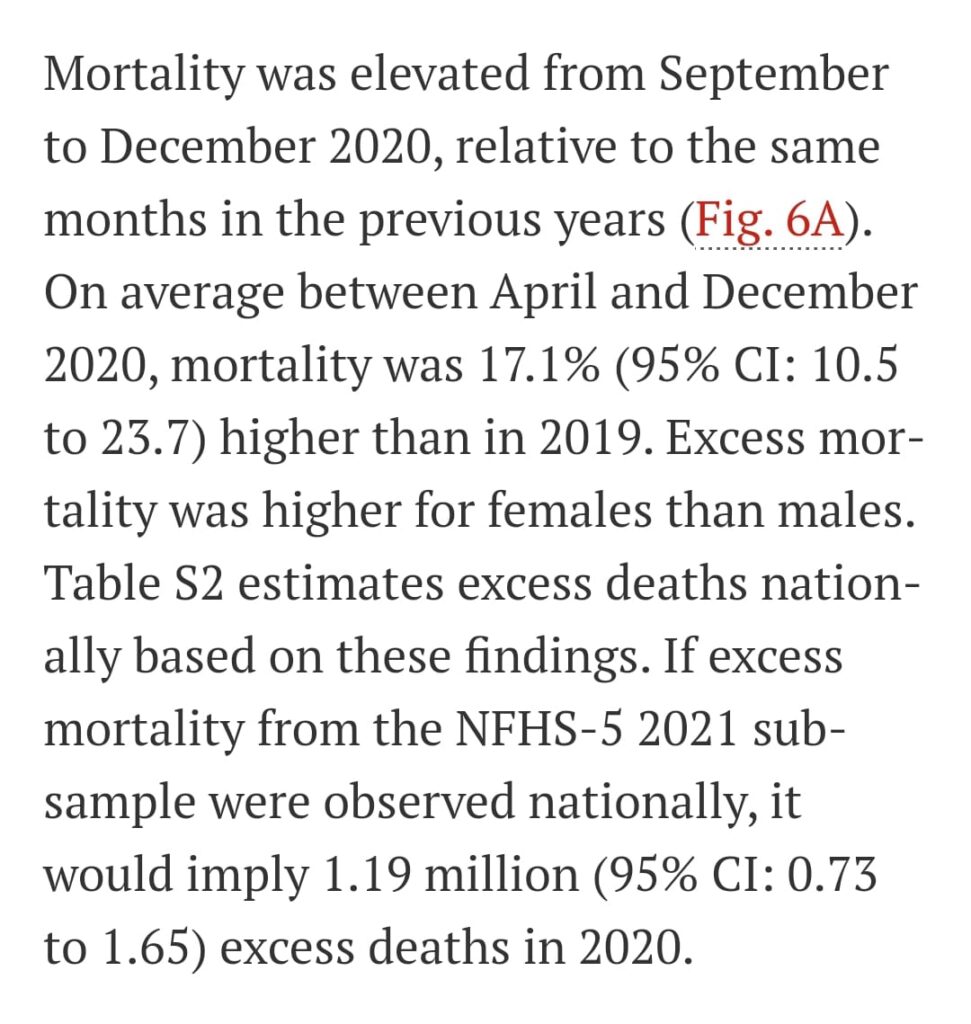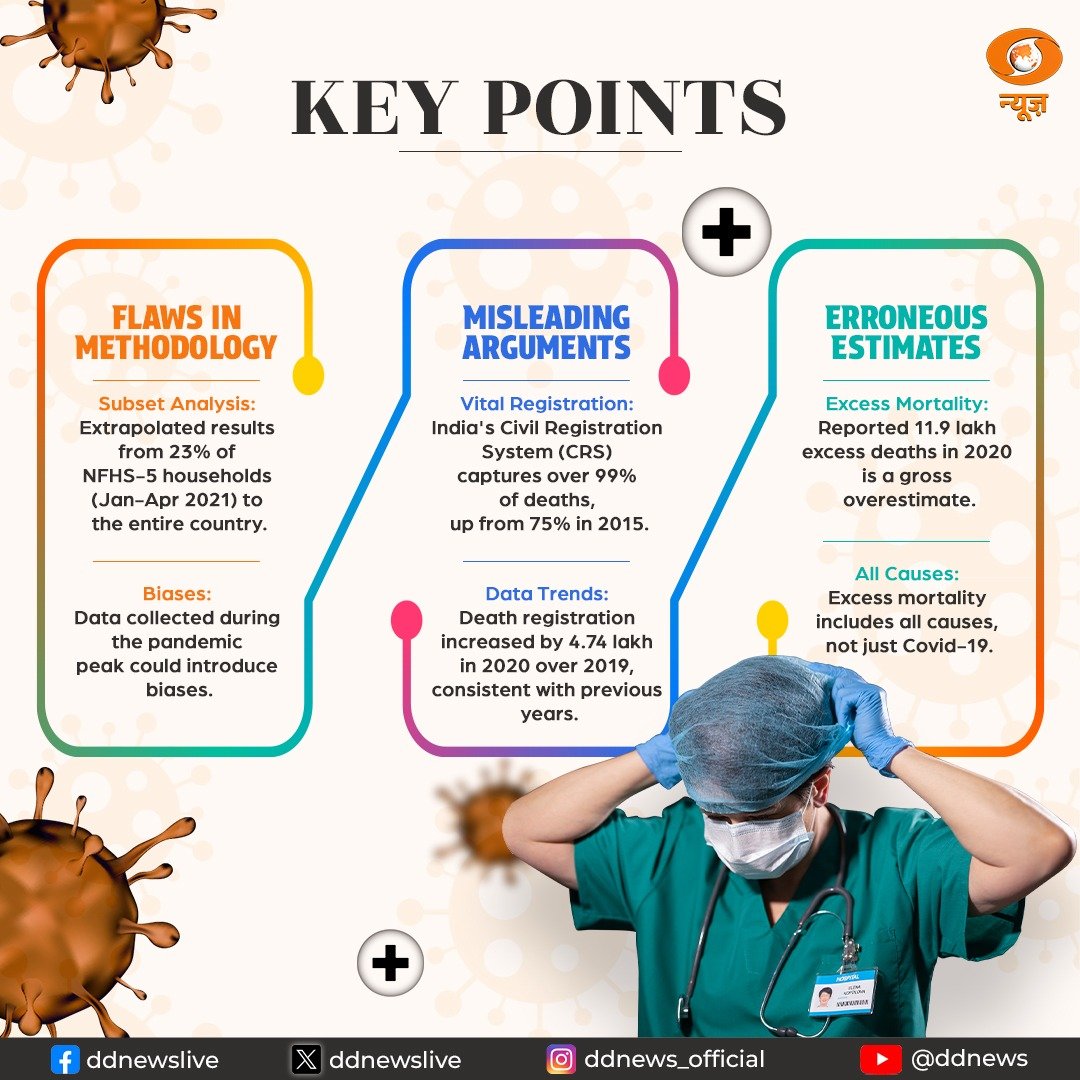ਅਮਰੀਕਾ ਦੀ ਇੱਕ ਰਿਪੋਰਟ ਨੇ ਭਾਰਤ ਵਿੱਚ ਪਾਇਆ ਭੜਥੂ – ’20 ਵਿੱਚ ਕੋਵਿਡ ਕਾਰਨ 11.9 ਲੱਖ ਮੌਤਾਂ ਵੱਧ ਹੋਣ ਦਾ ਦਾਹਵਾ – ਭਾਰਤ ਸਰਕਾਰ ਨੇ ਕੀਤਾ ਸਖ਼ਤ ਵਿਰੋਧ – ਪੜ੍ਹੋ ਰਿਪੋਰਟ
ਰਿਪੋਰਟ : ਨਿਊਜ਼ ਪੰਜਾਬ
ਅਮਰੀਕਾ ਦੇ ਇੱਕ ਅਕਾਦਮਿਕ ਜਰਨਲ, ਸਾਇੰਸ ਐਡਵਾਂਸ ਵਿੱਚ ਅੱਜ ਪ੍ਰਕਾਸ਼ਿਤ ਇੱਕ ਪੇਪਰ ਦੇ ਨਤੀਜੇ ਜਾਰੀ ਹੋਣ ਨਾਲ ਭਾਰਤ ਵਿੱਚ ਗੰਭੀਰ ਚਰਚਾ ਸ਼ੁਰੂ ਹੋ ਗਈ ਹੈ,ਸਾਇੰਸ ਐਡਵਾਂਸ ਵਿੱਚ ਪ੍ਰਕਾਸ਼ਿਤ ਰਿਪੋਰਟ ਵਿੱਚ ਕਿਹਾ ਗਿਆ ਕਿ 2020 ਵਿੱਚ ਕੋਵਿਡ ਕਾਰਨ 11.9 ਲੱਖ ਵੱਧ ਮੌਤਾਂ ਹੋਣ ਦਾ ਪ੍ਰਗਟਾਵਾ ਕੀਤਾ ਗਿਆ ਇਥੇ ਰਿਪੋਰਟ ਦਾ ਅਤੇ ਭਾਰਤ ਸਰਕਾਰ ਵੱਲੋਂ ਜਾਰੀ ਪੱਖ ਦੇ ਰਹੇ ਹਾਂ,  ਪੂਰੀ ਰਿਪੋਰਟ ਸਾਇੰਸ ਐਡਵਾਂਸ ਦੀ https://www.science.org/doi/10.1126/sciadv.adk2070 ਤੇ ਪੜੀ ਜਾ ਸਕਦੀ ਹੈ
ਪੂਰੀ ਰਿਪੋਰਟ ਸਾਇੰਸ ਐਡਵਾਂਸ ਦੀ https://www.science.org/doi/10.1126/sciadv.adk2070 ਤੇ ਪੜੀ ਜਾ ਸਕਦੀ ਹੈ
ਭਾਰਤ ਸਰਕਾਰ ਨੇ ਕਿਹਾ ਕਿ ਇਹ ਰਿਪੋਰਟ ਗੁੰਮਰਾਹਕੁੰਨ, ਅਸਪਸ਼ਟ ਅਤੇ ਅਸਵੀਕਾਰਨਯੋਗ ਧਾਰਨਾਵਾਂ ‘ਤੇ ਅਧਾਰਤ ਹਨ।
ਭਾਰਤ ਸਰਕਾਰ ਦੀ Ministry of Health and Family Welfare ਨੇ ਜਵਾਬ ਵਿੱਚ ਕਿਹਾ
“ਕੁਝ ਮੀਡੀਆ ਰਿਪੋਰਟਾਂ ਨੇ ਸਾਲ 2020 ਵਿੱਚ ਭਾਰਤ ਵਿੱਚ ਕੋਵਿਡ-19 ਮਹਾਂਮਾਰੀ ਦੇ ਦੌਰਾਨ ਜੀਵਨ ਦੀਆਂ ਸੰਭਾਵਨਾਵਾਂ ਬਾਰੇ ਇੱਕ ਅਕਾਦਮਿਕ ਜਰਨਲ, ਸਾਇੰਸ ਐਡਵਾਂਸ ਵਿੱਚ ਅੱਜ ਪ੍ਰਕਾਸ਼ਿਤ ਇੱਕ ਪੇਪਰ ਦੇ ਨਤੀਜੇ ਜਾਰੀ ਕੀਤੇ ਹਨ। ਇਹ ਅਸਪਸ਼ਟ ਅਤੇ ਅਸਵੀਕਾਰਨਯੋਗ ਧਾਰਨਾਵਾਂ ‘ਤੇ ਅਧਾਰਤ ਹਨ।ਹਾਲਾਂਕਿ ਲੇਖਕ ਨੈਸ਼ਨਲ ਫੈਮਿਲੀ ਹੈਲਥ ਸਰਵੇ-5 (NFHS-5) ਦੇ ਵਿਸ਼ਲੇਸ਼ਣ ਦੀ ਮਿਆਰੀ ਵਿਧੀ ਦੀ ਪਾਲਣਾ ਕਰਨ ਦਾ ਦਾਅਵਾ ਕਰਦੇ ਹਨ, ਪਰ ਉਹਨਾਂ ਦੀ ਕਾਰਜਪ੍ਰਣਾਲੀ ਵਿੱਚ ਗੰਭੀਰ ਖਾਮੀਆਂ ਹਨ। ਸਭ ਤੋਂ ਮਹੱਤਵਪੂਰਨ, ਲੇਖਕਾਂ ਨੇ ਜਨਵਰੀ ਅਤੇ ਅਪ੍ਰੈਲ 2021 ਦੇ ਵਿਚਕਾਰ ਕੀਤੇ ਗਏ NFHS ਸਰਵੇਖਣ ਵਿੱਚ ਸ਼ਾਮਲ ਪਰਿਵਾਰਾਂ ਦੇ ਇੱਕ ਉਪ ਸਮੂਹ ਦੀ ਵਰਤੋਂ ਕੀਤੀ, 2020 ਵਿੱਚ ਇਹਨਾਂ ਪਰਿਵਾਰਾਂ ਵਿੱਚ ਮੌਤ ਦਰ ਦੀ 2019 ਨਾਲ ਤੁਲਨਾ ਕੀਤੀ ਅਤੇ ਨਤੀਜਿਆਂ ਨੂੰ ਪੂਰੇ ਦੇਸ਼ ਵਿੱਚ ਲਾਗੂ ਕੀਤਾ ਗਿਆ ਹੈ। NFHS ਸਰਵੇਖਣ ਸਿਰਫ਼ ਦੇਸ਼ ਦਾ ਪ੍ਰਤੀਨਿਧ ਹੁੰਦਾ ਹੈ ਜਦੋਂ ਸਮੁੱਚੇ ਤੌਰ ‘ਤੇ ਮੰਨਿਆ ਜਾਂਦਾ ਹੈ। 14 ਰਾਜਾਂ ਦੇ ਇਸ ਵਿਸ਼ਲੇਸ਼ਣ ਵਿੱਚ ਸ਼ਾਮਲ 23 ਪ੍ਰਤੀਸ਼ਤ ਪਰਿਵਾਰਾਂ ਨੂੰ ਦੇਸ਼ ਦਾ ਪ੍ਰਤੀਨਿਧ ਨਹੀਂ ਮੰਨਿਆ ਜਾ ਸਕਦਾ ਹੈ। ਸਰਵੇਖਣ ਨਮੂਨੇ ਵਿੱਚ ਸੰਭਾਵੀ ਚੋਣ ਅਤੇ ਰਿਪੋਰਟਿੰਗ ਪੱਖਪਾਤ ਨਾਲ ਸਬੰਧਤ ਹੋਰ ਮਹੱਤਵਪੂਰਨ ਕਮੀਆਂ ਸ਼ਾਮਲ ਹਨ, ਕਿਉਂਕਿ ਜਦੋਂ ਇਹ ਡੇਟਾ ਇਕੱਠਾ ਕੀਤਾ ਗਿਆ ਸੀ, ਉਹ ਸਮਾਂ COVID-19 ਮਹਾਂਮਾਰੀ ਦੇ ਸਿਖਰ ਦੌਰਾਨ ਸੀ।
ਇੱਥੇ ਪ੍ਰਕਾਸ਼ਿਤ ਪੇਪਰ ਗਲਤ ਢੰਗ ਨਾਲ ਅਜਿਹੇ ਵਿਸ਼ਲੇਸ਼ਣ ਦੀ ਲੋੜ ਦੀ ਦਲੀਲ ਦਿੰਦਾ ਹੈ ਅਤੇ ਦਾਅਵਾ ਕਰਦਾ ਹੈ ਕਿ ਭਾਰਤ ਸਮੇਤ ਘੱਟ ਅਤੇ ਮੱਧ-ਆਮਦਨੀ ਵਾਲੇ ਦੇਸ਼ਾਂ ਵਿੱਚ ਮਹੱਤਵਪੂਰਨ ਰਜਿਸਟ੍ਰੇਸ਼ਨ ਪ੍ਰਣਾਲੀ ਕਮਜ਼ੋਰ ਹੈ। ਇਹ ਸੱਚਾਈ ਤੋਂ ਦੂਰ ਹੈ। ਭਾਰਤ ਵਿੱਚ ਸਿਵਲ ਰਜਿਸਟ੍ਰੇਸ਼ਨ ਸਿਸਟਮ (CRS) ਬਹੁਤ ਮਜ਼ਬੂਤ ਹੈ ਅਤੇ 99 ਪ੍ਰਤੀਸ਼ਤ ਤੋਂ ਵੱਧ ਮੌਤਾਂ ਬਾਰੇ ਜਾਣਕਾਰੀ ਪ੍ਰਦਾਨ ਕਰਦਾ ਹੈ। ਇਹ ਰਿਪੋਰਟਿੰਗ 2015 ਵਿੱਚ 75 ਪ੍ਰਤੀਸ਼ਤ ਤੋਂ ਵੱਧ ਕੇ 2020 ਵਿੱਚ 99 ਪ੍ਰਤੀਸ਼ਤ ਤੋਂ ਵੱਧ ਹੋ ਗਈ ਹੈ। ਇਸ ਪ੍ਰਣਾਲੀ ਦੇ ਅੰਕੜਿਆਂ ਤੋਂ ਪਤਾ ਚੱਲਦਾ ਹੈ ਕਿ ਸਾਲ 2019 ਦੇ ਮੁਕਾਬਲੇ ਸਾਲ 2020 ਵਿੱਚ ਮੌਤ ਦੀ ਰਜਿਸਟ੍ਰੇਸ਼ਨ ਵਿੱਚ 4.74 ਲੱਖ ਦਾ ਵਾਧਾ ਹੋਇਆ ਹੈ। ਪਿਛਲੇ ਸਾਲਾਂ ਦੇ ਮੁਕਾਬਲੇ ਸਾਲ 2018 ਅਤੇ 2019 ਵਿੱਚ ਮੌਤ ਦੀ ਰਜਿਸਟ੍ਰੇਸ਼ਨ ਵਿੱਚ 4.86 ਲੱਖ ਅਤੇ 6.90 ਲੱਖ ਦਾ ਵਾਧਾ ਹੋਇਆ ਹੈ। ਖਾਸ ਤੌਰ ‘ਤੇ, ਇੱਕ ਸਾਲ ਵਿੱਚ CRS ਵਿੱਚ ਸਾਰੀਆਂ ਵਾਧੂ ਮੌਤਾਂ ਮਹਾਂਮਾਰੀ ਦੇ ਕਾਰਨ ਨਹੀਂ ਹੁੰਦੀਆਂ ਹਨ। ਵਾਧੂ ਸੰਖਿਆ CRS ਵਿੱਚ ਮੌਤ ਦੀ ਰਜਿਸਟ੍ਰੇਸ਼ਨ ਵਿੱਚ ਵਾਧਾ (ਇਹ 2019 ਵਿੱਚ 92 ਪ੍ਰਤੀਸ਼ਤ ਸੀ) ਅਤੇ ਅਗਲੇ ਸਾਲ ਵਿੱਚ ਇੱਕ ਵੱਡੀ ਆਬਾਦੀ ਅਧਾਰ ਕਾਰਨ ਵੀ ਹੈ।
ਇਹ ਜ਼ੋਰਦਾਰ ਢੰਗ ਨਾਲ ਦਰਸਾਇਆ ਗਿਆ ਹੈ ਕਿ ਪਿਛਲੇ ਸਾਲ ਦੇ ਮੁਕਾਬਲੇ 2020 ਵਿੱਚ ਲਗਭਗ 11.9 ਲੱਖ ਮੌਤਾਂ ਦੀ ਜ਼ਿਆਦਾ ਮੌਤ ਵਿਗਿਆਨ ਐਡਵਾਂਸ ਪੇਪਰ ਵਿੱਚ ਇੱਕ ਘੋਰ ਅਤੇ ਗੁੰਮਰਾਹਕੁੰਨ ਅਨੁਮਾਨ ਹੈ। ਮਹਾਂਮਾਰੀ ਦੌਰਾਨ ਜ਼ਿਆਦਾ ਮੌਤ ਦਰ ਦਾ ਮਤਲਬ ਹੈ ਸਾਰੇ ਕਾਰਨਾਂ ਤੋਂ ਹੋਣ ਵਾਲੀਆਂ ਮੌਤਾਂ ਵਿੱਚ ਵਾਧਾ, ਅਤੇ ਇਸ ਨੂੰ ਸਿੱਧੇ ਤੌਰ ‘ਤੇ ਕੋਵਿਡ-19 ਕਾਰਨ ਹੋਈਆਂ ਮੌਤਾਂ ਦੇ ਬਰਾਬਰ ਨਹੀਂ ਮੰਨਿਆ ਜਾ ਸਕਦਾ।
ਖੋਜਕਰਤਾਵਾਂ ਦੁਆਰਾ ਪ੍ਰਕਾਸ਼ਿਤ ਅਨੁਮਾਨਾਂ ਦੀ ਪੁਸ਼ਟੀ ਭਾਰਤ ਦੇ ਨਮੂਨਾ ਰਜਿਸਟ੍ਰੇਸ਼ਨ ਪ੍ਰਣਾਲੀ (SRS) ਦੇ ਅੰਕੜਿਆਂ ਦੁਆਰਾ ਵੀ ਕੀਤੀ ਜਾਂਦੀ ਹੈ। SRS ਦੇਸ਼ ਦੇ 36 ਰਾਜਾਂ/ਕੇਂਦਰ ਸ਼ਾਸਿਤ ਪ੍ਰਦੇਸ਼ਾਂ ਵਿੱਚ ਫੈਲੇ 8842 ਨਮੂਨਾ ਯੂਨਿਟਾਂ ਵਿੱਚ 24 ਲੱਖ ਪਰਿਵਾਰਾਂ ਵਿੱਚ ਲਗਭਗ 84 ਲੱਖ ਆਬਾਦੀ ਨੂੰ ਕਵਰ ਕਰਦਾ ਹੈ। ਹਾਲਾਂਕਿ ਲੇਖਕ ਇਹ ਦਰਸਾਉਣ ਲਈ ਬਹੁਤ ਦਰਦ ਲੈਂਦੇ ਹਨ ਕਿ ਸਾਲ 2018 ਅਤੇ 2019 ਲਈ NFHS ਵਿਸ਼ਲੇਸ਼ਣ ਅਤੇ ਨਮੂਨਾ ਰਜਿਸਟ੍ਰੇਸ਼ਨ ਸਰਵੇਖਣ ਵਿਸ਼ਲੇਸ਼ਣ ਦੇ ਨਤੀਜੇ ਤੁਲਨਾਤਮਕ ਹਨ, ਉਹ ਇਹ ਰਿਪੋਰਟ ਕਰਨ ਵਿੱਚ ਪੂਰੀ ਤਰ੍ਹਾਂ ਅਸਫਲ ਰਹਿੰਦੇ ਹਨ ਕਿ ਸਾਲ 2020 ਵਿੱਚ SRS ਡੇਟਾ ਸਾਲ ਦੇ ਡੇਟਾ ਨਾਲ ਤੁਲਨਾਯੋਗ ਹੈ। 2019 (2019 ਵਿੱਚ 6.0/1000 ਦੀ ਕੱਚੇ ਮੌਤ ਦਰ ਦੇ ਮੁਕਾਬਲੇ 2019 ਵਿੱਚ 6.0/1000 ਦੀ 2020 ਕੱਚੀ ਮੌਤ ਦਰ) ਬਹੁਤ ਘੱਟ, ਜੇਕਰ ਕੋਈ ਹੈ, ਤਾਂ ਜ਼ਿਆਦਾ ਮੌਤ ਦਰ ਅਤੇ ਜੀਵਨ ਸੰਭਾਵਨਾਵਾਂ ਵਿੱਚ ਕੋਈ ਕਮੀ ਨੂੰ ਦਰਸਾਉਂਦੀ ਹੈ।
ਪੇਪਰ ਉਮਰ ਅਤੇ ਲਿੰਗ ਦੇ ਆਧਾਰ ‘ਤੇ ਨਤੀਜੇ ਪੇਸ਼ ਕਰਦਾ ਹੈ ਜੋ ਭਾਰਤ ਵਿੱਚ ਕੋਵਿਡ-19 ‘ਤੇ ਖੋਜ ਅਤੇ ਪ੍ਰੋਗਰਾਮਾਂ ਦੇ ਅੰਕੜਿਆਂ ਦੇ ਉਲਟ ਹਨ। ਪੇਪਰ ਦਾਅਵਾ ਕਰਦਾ ਹੈ ਕਿ ਔਰਤਾਂ ਅਤੇ ਛੋਟੀ ਉਮਰ ਦੇ ਸਮੂਹਾਂ (ਖਾਸ ਕਰਕੇ 0-19 ਸਾਲ ਦੀ ਉਮਰ ਦੇ ਬੱਚੇ) ਵਿੱਚ ਵਧੇਰੇ ਮੌਤ ਦਰ ਜ਼ਿਆਦਾ ਸੀ। ਕੋਵਿਡ-19 ਕਾਰਨ ਦਰਜ ਕੀਤੀਆਂ ਗਈਆਂ ਲਗਭਗ 5.3 ਲੱਖ ਮੌਤਾਂ ਦੇ ਅੰਕੜਿਆਂ ਦੇ ਨਾਲ-ਨਾਲ ਸਮੂਹਾਂ ਅਤੇ ਰਜਿਸਟਰੀਆਂ ਦੇ ਖੋਜ ਡੇਟਾ, ਮਰਦਾਂ (2:1) ਅਤੇ ਵੱਡੀ ਉਮਰ ਦੇ ਸਮੂਹਾਂ (0:1) ਵਿੱਚ ਕੋਵਿਡ-19 ਕਾਰਨ ਮੌਤ ਦਰ ਉੱਚੀ ਦਰਸਾਉਂਦੇ ਹਨ। ਔਰਤਾਂ ਨਾਲੋਂ – 15 ਸਾਲ ਦੀ ਉਮਰ ਦੇ ਲੋਕਾਂ ਨਾਲੋਂ 60 ਸਾਲ ਤੋਂ ਵੱਧ ਉਮਰ ਦੇ ਲੋਕਾਂ ਵਿੱਚ ਕਈ ਗੁਣਾ ਵੱਧ)। ਪ੍ਰਕਾਸ਼ਿਤ ਪੇਪਰ ਵਿੱਚ ਇਹ ਅਸੰਗਤ ਅਤੇ ਅਸਪਸ਼ਟ ਨਤੀਜੇ ਇਸਦੇ ਦਾਅਵਿਆਂ ਵਿੱਚ ਕਿਸੇ ਵੀ ਵਿਸ਼ਵਾਸ ਨੂੰ ਕਮਜ਼ੋਰ ਕਰਦੇ ਹਨ।
ਸਿੱਟੇ ਵਜੋਂ, 2020 ਵਿੱਚ ਭਾਰਤ ਵਿੱਚ ਸਾਰੇ ਕਾਰਨਾਂ ਤੋਂ ਵੱਧ ਮੌਤ ਦਰ ਪਿਛਲੇ ਸਾਲ ਦੇ ਮੁਕਾਬਲੇ ਸਾਇੰਸ ਐਡਵਾਂਸ ਪੇਪਰ ਵਿੱਚ ਦਰਜ 11.9 ਲੱਖ ਮੌਤਾਂ ਨਾਲੋਂ ਬਹੁਤ ਘੱਟ ਹੈ। ਅੱਜ ਪ੍ਰਕਾਸ਼ਿਤ ਪੇਪਰ ਵਿਧੀਗਤ ਤੌਰ ‘ਤੇ ਨੁਕਸਦਾਰ ਹੈ ਅਤੇ ਨਤੀਜੇ ਦਿਖਾਉਂਦਾ ਹੈ ਜੋ ਅਸਪਸ਼ਟ ਅਤੇ ਅਸਵੀਕਾਰਨਯੋਗ ਹਨ।
Ministry of Health and Family Welfare
Media reports highlighting Excess Mortality in 2020 from study in journal Science Advances based on untenable and unacceptable estimates
Excess mortality reported in the Science Advances paper in 2020 over the previous year is a gross and misleading overestimate
The study is erroneous and methodology followed by the authors has critical flaws; the claims are inconsistent and unexplainable
The all-cause excess mortality in 2020 compared with the previous year in India is markedly less than the 11.9 lakh deaths reported in the Science Advances paper
Discrepancies between the study’s findings and established Covid-19 mortality patterns further undermine its credibility
Study fails to acknowledge India’s robust Civil Registration System (CRS), which recorded a substantial increase in death registrations (over 99%) in 2020, not solely attributable to the pandemic
Some media reports have highlighted the findings from a paper published today in an academic journal Science Advances on life expectancy during the Covid-19 pandemic in India in 2020. These are based on untenable and unacceptable estimates.
While the authors claim to follow standard methodology of analyzing National Family Health Survey-5 NFHS-5), there are critical flaws in methodology. The most important flaw is that the authors have taken a subset of households included in the NFHS survey between January and April 2021, compared mortality in these households in 2020 with 2019, and extrapolated the results to the entire country. The NFHS sample is representative of the country only when it is considered as a whole. The 23% of households included in this analysis from part of 14 states cannot be considered representative of the country. The other critical flaw is related to possible selection and reporting biases in the included sample due to the time in which these data were collected, at the peak of the Covid-19 pandemic.
The paper erroneously argues for the need for such analyses claiming that vital registration system in low and middle income countries including India is weak. This is far from being correct. The Civil Registration System (CRS) in India is highly robust and captures over 99% of deaths. This reporting has constantly increased from 75% in 2015 to over 99% in 2020. Data from this system shows death registration has increased by 4.74 lakh in the year 2020 compared to 2019. There was a similar increase of 4.86 lakh and 6.90 lakh in death registration in the year 2018 and 2019 over the respective previous years. Notably, all excess deaths in a year in the CRS are not attributable to the pandemic. Excess number is also due to an increasing trend of death registration in CRS (it was 92% in 2019) and a larger population base in the succeeding year.
It is strongly asserted that an excess mortality of about 11.9 lakh deaths reported in the Science Advances paper in 2020 over the previous year is a gross and misleading overestimate. It is noteworthy that excess mortality during the pandemic means increase in deaths due to all causes, and cannot be equated with deaths that were directly caused by Covid-19.
The erroneous nature of the estimates published by the researchers is further corroborated by data from India’s Sample registration System (SRS). SRS covers around 84 lakhs population in 24 lakh households in 8842 sample units spread across 36 States/UTs in the country. While the authors take great pains to show that results from NFHS analyses and Sample Registration Survey analyses for 2018 and 2019 are comparable, they completely fail to report that SRS data in 2020 shows very little, if any, excess mortality compared with 2019 data (Crude death rate 6.0/1000 in 2020, Crude death rate 6.0/1000 in 2019) and no reduction in life expectancy.
The paper reports results on age and sex, that are contrary to research and program data on Covid-19 in India. The paper claims that excess mortality was greater in females and in younger age groups (particularly 0-19 year old children). Data on about 5.3 lakh recorded deaths due to Covid-19, as well as research data from cohorts and registries consistently shows higher mortality due to Covid-19 in males than females (2:1) and in older age groups (several fold higher in > 60 years olds than in 0-15 year old children). These inconsistent and unexplainable results in the published paper further reduce any confidence in its claims.
In conclusion, the all-cause excess mortality in 2020 compared with the previous year in India is markedly less than the 11.9 lakh deaths reported in the Science Advances paper The paper published today is methodologically flawed and shows results that are untenable and unacceptable.
***

